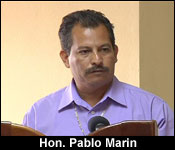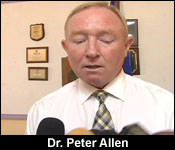Last night, 7News showed you the first part of a 2 part series where our newsroom took a very close look at the PAHO report, which was released last week.
Well Tonight, Daniel Ortiz focused on the importance of the Karl Heusner Memorial Hospital's infection control mechanism, which was discovered to have been handicapped.
He also looked at the very clear picture presented by the PAHO investigators about what caused the bacterial breakout, which claimed the lives of its neonatal patients:
Daniel Ortiz reporting
The PAHO Report also points to very little training in infection control. It says,
Page 9
"There is evidence that the hospital staff in its different areas has been trained in basic principles for infection control and prevention since 2008, at a beginning as a very short introduction with a few hours of information and currently as a two days course. This training has been given to personnel on duty and to the newly hired entrants. There is no assessment of knowledge acquired in this training."
And the PAHO investigators made significant observations about the Hospital's Microbiology laboratory. This important unit is like the eyes of the Hospital, keeping a look out on infection breakouts. The investigators seemed to suggest that the hospital is blind, or something very close to it.
They say,
Page 11
"The laboratory within the hospital does not have capability for culture and susceptibility microbiological tests, therefore the samples are processed in the Central Medical Lab (CML).
The CML has the capacity to use automated identification systems or commercial manual methods, but lacks the supplies to run those tests in a routine basis.
Due to the lack of supplies, since February, 2013 the lab has been using home-made manual methods for the identification of gram negative bacteria. Manual methods also limited the susceptibility reports to a few antibiotics. The manual methods for culture and sensitivity lacked quality control measures."
Well, the Ministry is taking steps to the upgrade the CML:
Hon. Pablo Marin - Minister of Health
 "The government through my ministry is making available three hundred thousand for the renovation of the middle floor of the central medical laboratory. The government through the ministry and the UNDP is making available eighty thousand for renovation to the ground floor of the cetral medical laboratory."
"The government through my ministry is making available three hundred thousand for the renovation of the middle floor of the central medical laboratory. The government through the ministry and the UNDP is making available eighty thousand for renovation to the ground floor of the cetral medical laboratory."
The Minister didn't get into any details about what that upgrading process is, but the PAHO report notes that highly specialized equipment is needed for lab to do its work properly. But, the families of the dead neonates won't enjoy these upgrades, and they won't know exactly happened to cause the deaths because the lab technicians discarded the evidence.
According to Investigators:
Page 11
"The original specimens from the recent outbreak of E. cloacae were discarded due to the constrained space. Further testing and finger printing by pulse field gel electrophoresis that could have confirmed cross-transmission in the hospital environment could not be performed."
So, further testing that could have assisted them in finding out exactly what happened, cannot take place. The CEO says that it was not done for any sinister motive, or due to the staff trying to hide anything.
Dr. Francis Gary Longsworth - CEO, KHMH
 "I do not think they were aware of that, that's the lab and the lab technicians that work in a particular area of the lab. The technicians at the lab were not aware that those particular samples were related to an outbreak. They just did their work and they followed their routine. It's not that somebody went in said 'bway throw away those samples', I don't think it happened like that at all and it is not that that the samples were not tested. The samples were subjected to testing at the lab. When the experts came in to investigate the outbreak they would have liked to have sent the samples abroad for much more advance testing which we do not have available in Belize. Gel field electroscopic is not available in Belize."
"I do not think they were aware of that, that's the lab and the lab technicians that work in a particular area of the lab. The technicians at the lab were not aware that those particular samples were related to an outbreak. They just did their work and they followed their routine. It's not that somebody went in said 'bway throw away those samples', I don't think it happened like that at all and it is not that that the samples were not tested. The samples were subjected to testing at the lab. When the experts came in to investigate the outbreak they would have liked to have sent the samples abroad for much more advance testing which we do not have available in Belize. Gel field electroscopic is not available in Belize."
We'll have to take his word for it because he is the authority on such medical matters. But following along the report, the PAHO observers found a procedure by hospital staff which concerned them very greatly.
Page 12
The report says:
"It is a regular practice seen in pediatrics and neonatology to prepare intravenous medications left in syringes for up to 48 hours. These syringes are piled up in a small container and are to be used for several patients up until their expiry date, which is labeled in a tape surrounding each syringe. This practice was already seen in the assessment done in august 2011, and was observed as a high risk practice. The only change observed since the first report was in shortening the expiry date from 7 days to 48 hours. Being a high risk practice for patients (contamination) and for personnel (needle puncture) it should be eliminated."
When questioned about it, the CEO says that a change was made, just not the change which was initially recommended of discarding it completely.
Dr. Francis Gary Longsworth
"In the context of the report, a change was made from several days of storage to a maximum of 48 hours of storage - so we did comply."
But they didn't comply fully with what was suggested in 2011. The report shows clearly what the PAHO investigators think probably happened. They did so by explaining the nature of the bacteria E. cloacae, and the possible mode of transmission.
Page 14
"Since this bacterium was isolated in blood samples and its transmission is via the oral-fecal route, the most plausible explanation for this infection is through contamination of any device for intravenous puncture or intravenous medication used in these patients. Their prematurity implies management with intravenous therapies permanently since their admission. The regular practice of using multi-dose syringes shared for many patients and kept in use for at least 48 hours confers a high risk of contamination by any handler."
That seems to explain as best as possible what caused the outbreak, but the CEO wasn't convinced.
Dr. Francis Gary Longsworth
"We accept that the outbreak occurred, you know, but specifically we do not know the source of the outbreak and that is contained in the report"
And the only technical personality at the head table who was willing to deal with that concern directly was the CEO of the Ministry of Health.
Reporter
"It's intravenous the way these bacteria infected the neonates?"
Dr. Peter Allen - CEO Ministry of Health
 " Yes, that is exactly what the PAHO report says and it says that the most likely route of the infection is from transmissions through introvenal therapies."
" Yes, that is exactly what the PAHO report says and it says that the most likely route of the infection is from transmissions through introvenal therapies."
Reporter
"So would you accept that it occurred in the Neonatal Intensive Care Unit."
Dr. Peter Allen
"Well I would accept exactly what the report suggests that, that is the most likely route of the infection."
The Ministry of Health and the KHMH Authority has pledged to activate all the improvements which have been recommended by the PAHO investigating team.



